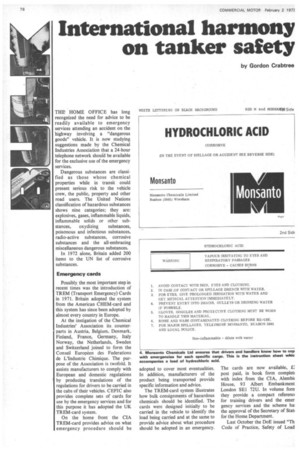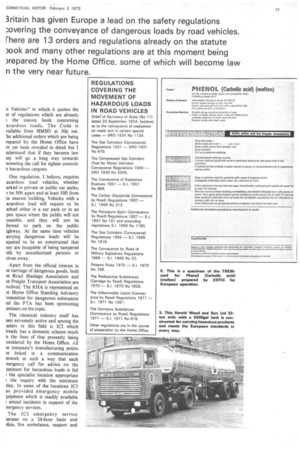International harmony on tanker safety
Page 78

Page 79

Page 80

If you've noticed an error in this article please click here to report it so we can fix it.
by Gordon Crabtree THP HOME OFFICE has long recognized the need for advice to be readily available to emergency services attending an accident on the highway involving a "dangerous goods" vehicle. It is now studying suggestions made by the Chemical Industries Association that a 24-hour telephone network should be available for the exclusive use of the emergency services.
Dangerous substances are classified as those whose chemical properties while in transit could present serious risk to the vehicle crew, the public, property and other road users. The United Nations classification of hazardous substances shows nine categories; they are: explosives, gases, inflammable liquids, inflammable solids or other substances, oxydizing substances, poisonous and infectious substances, radio-active substances, corrosive substances and the all-embracing miscellaneous dangerous substances.
In 1972 alone, Britain added 200 items to the UN list of corrosive substances.
Emergency cards
Possibly, the most important step in recent times was the introduction of TREM (Transport Emergency) Cards in 1971. Britain adopted the system from the American CHEM-card and this system has since been adopted by almost every country in Europe.
At the instigation of the Chemical Industries' Association its counterparts in Austria, Belgium, Denmark, Finland, France, Germany, Italy Norway, the Netherlands, Sweden and Switzerland joined to form the Conseil Europeen des Federations de L'Industrie Chimique. The purpose of the Association is twofold. It assists manufacturers to comply with European and domestic regulations by producing translations of the regulations for drivers to be carried in the cabs of their vehicles. CEFIC also provides complete sets of cards for use by the emergency services and for this purpose it has adopted the UK TREM-card system.
On the home front the CIA TREM-card provides advice on what emergency procedure should be adopted to cover most eventualities. In addition, manufacturers of the product being transported provide specific information and advice.
The TREM-card system illustrates how bulk consignments of hazardous chemicals should be identified. The cards were designed initially to be carried in the vehicle to identify the load being carried and at the same to provide advice about what procedure should be adopted in an emergency. The cards are now available, £: post paid, in book form complet1 with index from the CIA, Alembic House, 93 Albert Embankment London SE1 72U. In volume fom they provide a compact referenc( for training drivers and the emer gency services and the scheme ha the approval of the Secretary of Stat.( for the Home Department.
Last October the DoE issued "Th Code of Practice, Safety of Load n Vehicles" in which it quotes the St of regulations which are already the statute book concerning azardous loads. The Code is vailable from HMSO at 30p net. 'he additional orders which are being repared by the Home Office have ot yet been revealed in detail but I nderstand that if they become law tey will go a long way towards nswering the call for tighter controls n hazardous cargoes.
One regulation, I believe, requires azardous load vehicles, whether larked in private or public car parks, a be 50ft apart and at least 50ft from he nearest building. Vehicles with a azardous load will require to be ,arked either in a car park or in an pen space where the public will not ssemble, and they will not be llowed to park on the public ighway. At the same time vehicles arrying dangerous loads will be equired to be so constructed that hey are incapable of being tampered pith by unauthorized persons or riven away.
Apart from the official interest in le carriage of dangerous goods, both le Road Haulage Association and le Freight Transport Association are ivolved. The RHA is represented on le Home Office Standing Advisory :ommittee for dangerous substances nd the PTA has been sponsoring !minus on the topic.
The chemical industry itself has een extremely active and among the :aders in this field is ICI which [ready has a domestic scheme much n the lines of that presently being onsidered by the Home Office. All ie company's manufacturing points re linked in a communication etwork in such a way that each riergency call for advice on the .eatment for hazardous loads is fed ) the specialist location appropriate ) the inquiry with the minimum clay. In some of the locations ICI as provided emergency mobile plipment which is readily available
attend incidents in support of the nergency services.
The ICI emergency service mrates on a 24-hour basis and )lice, fire ambulance, seaport and airport authorities have full details of the communications network.
Mr A. E. Meadowcroft, the distribution and development manager of Monsanto Chemicals Ltd in Brussels, told me that his company clearly defined the safety role of each of its operators and that each consignment was labelled before leaving the plant with weather-proof plates showing a description of the product, the type and degree of hazard, what emergency action should be implemented in the event of an incident and a list of the manned telephone contacts. Monsanto's drivers undergo product fluniliarization training and each vehicle is supplied with a TREM-card.
Monsanto extends its safety procedures to hauliers and consignees who are reminded periodically in writing of the safety requirements both for goods in transit and during unloading operations.
Tanker operators Mr E. W. Tomlinson, director and general manager of Arrow Bulk Carriers Ltd, of Hull, is chairman of the bulk liquids functional group of the RHA. His company has permanent classroom facilities and an instructor-cum-supervisor whose sole task it is to maintain safety standards of both drivers and handlers. Mr Tomlinson stressed that bulk chemical carriers were well aware of their public responsibilities. He added that from a purely economic point of view operators took care to ensure that both their vehicles and their drivers were fit for the job — "after all we have a great deal at stake with a very high capital cost involved".
Despite the massive legislation which has hit the transport industry in recent years, Mr Tomlinson assures me that tanker operators involved in the transport of hazardous loads are ready to accept any new legislation which the authorities consider necessary to improve the safety of their vehicles.
Mr Tomlinson pointed out that a high degree of maintenance had always been high on the priority list of bulk carriers. There is a feeling among bulk carrier operators that whereas in general haulage bad maintenance amounts to bad management, in hazardous load haulage it would be criminal.
















































































































































